Table of Contents
 If you’re still stuffing keywords in your content, you got to stop. Google has got smart enough to penalize contents with overstuffed keywords. This has nothing to do with keyword research mistakes but your site will get all the hate from Google Panda Update.
If you’re still stuffing keywords in your content, you got to stop. Google has got smart enough to penalize contents with overstuffed keywords. This has nothing to do with keyword research mistakes but your site will get all the hate from Google Panda Update.
But if you’re playing by the rules and still wonder why you did not get the traffic and the ranking that your content deserved, you may have committed these keyword research mistakes unknowingly. Some may have denied you a rightful place in Google search results. Others may have cost you money making opportunities.
Anyway, here’s the list of keyword research mistakes that could be hampering your SEO efforts.
1. Short-Tail or Generic Keywords.
If you’re starting a blog that intends to monetize on sports shoes, chances are you’re thinking of publishing a series of blog posts that targets the keyword “sports shoes“.
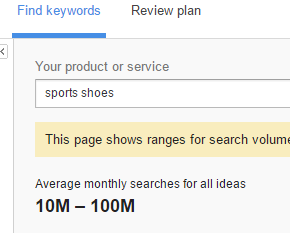
Big mistake here.
Yes, there is an average of 50 million people searching for “sports shoes” on Google. But the reality is, the top rankers for short keywords like this are major websites with very high domain authority. Just do a quick search for “sports shoes” on Google and you’ll get these.
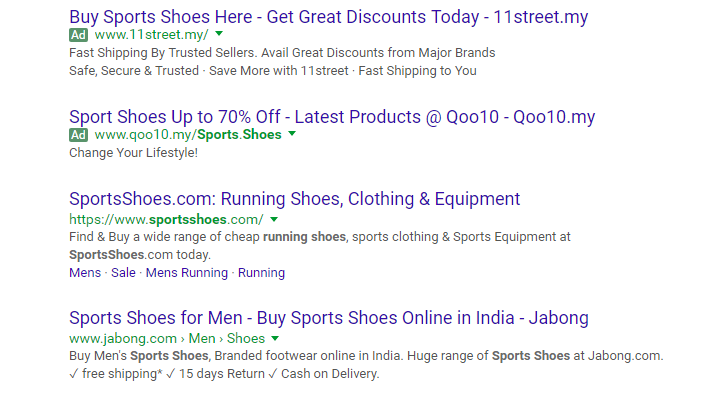
It’s definitely a profitable keyword as the are four sponsored results appearing in my search results. But you’ll have to compete with sites like sportsshoes.com which has a domain authority score of 52. If you’re publishing from a new website, chances are your domain authority is just below 20. (Here’s a free tool to check your domain authority).
The possibility of outranking these high authority websites with your pretty new blog within a short period? You’ll have a better chance striking the jackpot.
Solution?
Target long tail keywords instead.
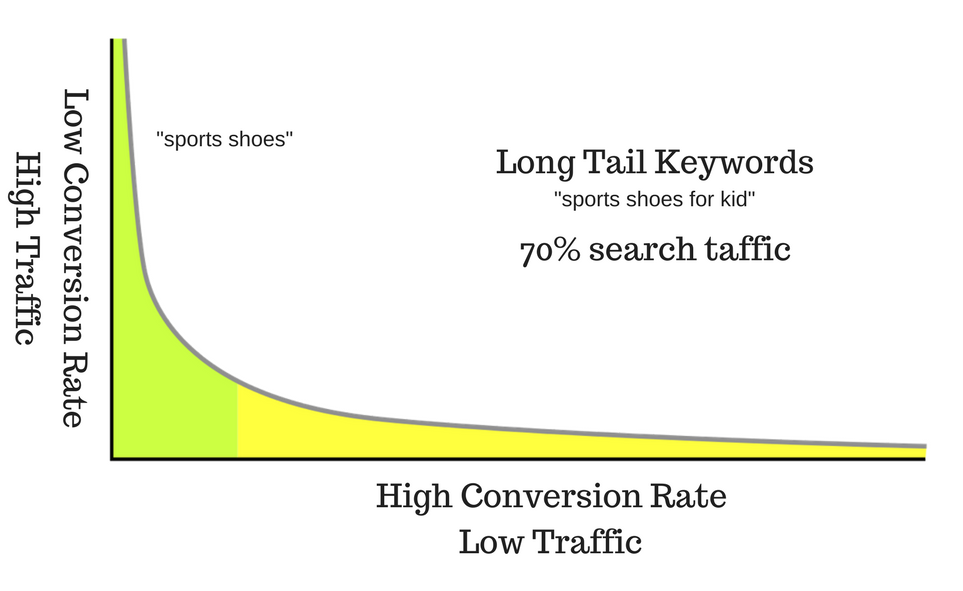
You’ll stand a better chance of ranking faster in Google when you target phrases that are made of 4-5 words.
It doesn’t mean that you won’t be competing with high domain sites here, but you’ll have lesser of them to deal with for long tail keywords. Also, people who are searching for longer phrases have a higher chance of making a purchase.
Here’s an article on ShoutMeLoud with awesome tips for finding long tail keywords.
2. Keywords With Little or No Traffic
While you may want to avoid 1 or 2 words phrase when you’re building up your blog, you don’t want to end up at the other extreme with keywords with little to no traffic.
You may think that there could be a market for second-hand sports shoes for kids and thought “used sports shoes for children” could be a good idea for your next post.
Here’ the part where you googled “used sports shoes for children” and gladly pointed out that there are more than 16 million results and surely, there must be demand and traffic for this search term.
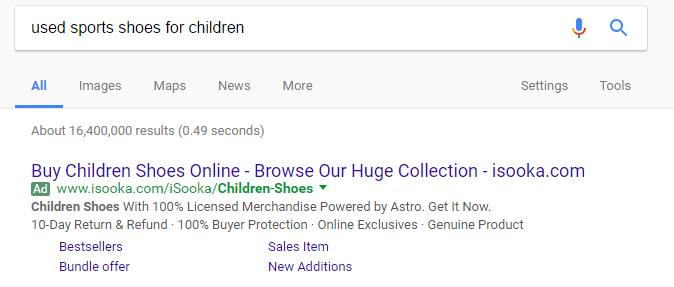
So you published a post with this particular keywords, promoted over and over again and you wondered why there is not a single organic traffic for this page.
Solution?
Always check how much traffic you are expecting with Google Keyword Planner or other similar tools.

Yes. There is totally no monthly searches for that particular search term. But how did this happen? Well, that leads us to the next common keyword research mistake.
3. Searching for Broad Match rather than Phrase Match.
First thing first, when you search on Google in a typical manner, it shows you a broad match, instead of phrase match. Ben Hunt has a very good explanation on what is a broad match here.
Most people do their keyword research by typing in Google like this

Broad match results give a pretty inaccurate number of results as it listed every single page that has one or more of the words in the phrase.
Solution?
Here’s what you should type to get results that contain all the words in the keyword.

As you can see, there are only 4 matching results. Think of all the wasted time and afford to craft a lengthy content if you have based the result on broad match.
4. Using Singular instead of Plural (or vice versa)
Say, you’re thinking of doing a post to attract parents looking for a good bargain for their kid. So you got a long tail keyword with pretty decent traffic and very little competitor with “kids shoe on sale“.
Doing a phrase match search on Google indicates there are only 28 competing results.
Wait.
Why did I say 28 results when it clearly shows “About 4,530 results” below?
Simply navigate to the last page of the search result, and you’ll get what you call the “Quoted Search Result” or QSR. Check out the image below. The QSR for “kids shoe on sale” is 28.

So you published your post but you found you have difficulty ranking high and getting the traffic you desired. And all of a sudden you’re up against a host of major websites like shoebuy.com and footlocker.com.
Why?
Because you overlooked the fact that most users search “kids shoes on sale” instead of the singular ‘shoe’.
Solution?
When you are in doubt whether you should drop a ‘s’ or not, use Google Trend to check it out.
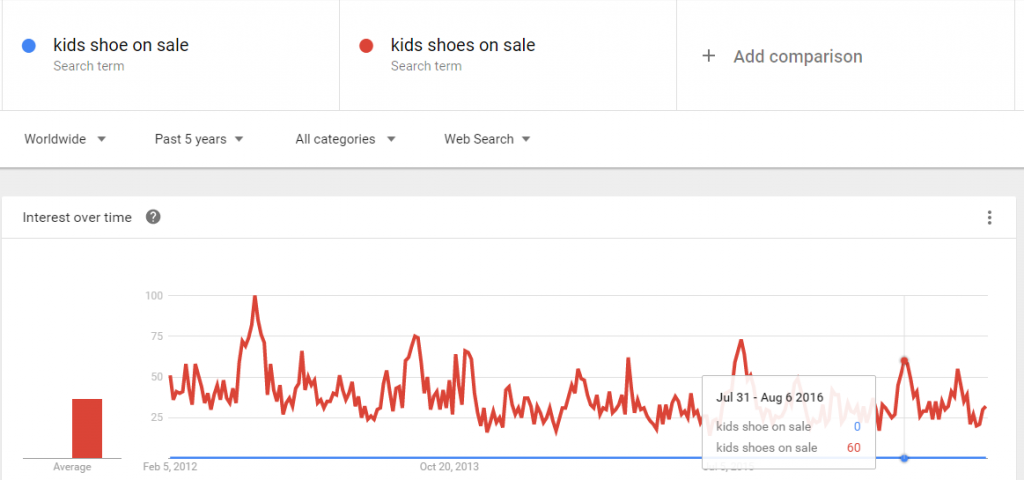
It’s shocking how omitting a single ‘s’ could be the biggest mistake of your keyword research.
5. Targeting keywords that are on a downward trend.
You don’t want to waste your time building contents after contents just to realized that by the time you outranked all your competitors, the traffic just disappeared.
Sounds scary isn’t it?
That’s what happens when you build contents around the keyword “Toms shoes for women“. A quick check on Google shows there are only 90 competing sites for the exact phrase (QSR 90) and drawing a monthly search traffic between 1K to 10K.
What could go wrong with it? Well, pretty much, if you’re working on a downhill trend.
Solution?
Use Google Trend to gauge if your primary keyword is trending or losing demand over time. I mentioned “primary keyword” because Google Trend normally couldn’t return any data for long tail keywords.
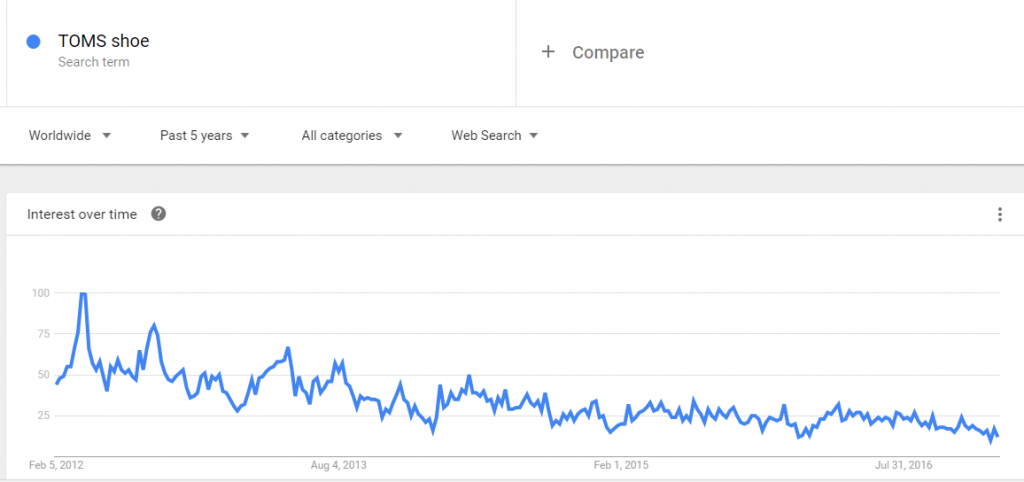
Here’s the result. A quick analysis that doesn’t take more than 60 seconds could determine the fate of your search traffic years down the line.
6. You don’t understand user intent.
When users searched “running shoes buying guides“, and your content offers nothing but an endless list of bargain running shoes from E-Bay, you risked turning away buyers for good.
The same goes to choking your readers with too much information on how to choose the best running shoe when they are searching for “Best Running Shoes”
The trick to keeping Google happy is giving your readers the content that they expected.
Bottom line is, you need to know if your readers are actually looking for general information, comparison, guides, reviews or ready to make an actual purchase.
Solution
A simple way is actually keying in phrases that you think your users would use in Google and analyze the content of the top search results. You can also check user’s behavior by visiting forums or sites like Quora and Yahoo Answers.
7. You use boring titles.
Boring titles are boring. Enough said.
The keyword “How To Choose Running Shoes” is actually a pretty competitive keyword in terms of monthly searches and competition. But the internet is full of bland “How to..” guides and users are tired of reading the same old thing again.
You could have produced some epic in-depth content but if your title is going to say “How To Choose Running Shoes”, you are going to lose traffic to another page that says “How To Select The Best Running Shoes For Comfort And Style ”
Why? Plainly because most users are attracted to catchy titles and just simply doesn’t bother to click on plain and boring ones.
You can do a simple scan on the search result and I’ll bet most of the top results have catchy and creative titles.
Solution
You don’t need to be an award-winning author to come up with catchy titles. It takes time and constant practice to deliver awesome titles. Jeff Goins mentioned in his article that using numbers and adjectives are among many tricks to writing catchy titles.
8. You are using irrelevant keywords.

You crafted 1,500 words in-depth content based on the keyword “how to choose a running shoe“. It looks promising with around 120 searches a month with 141 competing results. You hit published and you waited for a month for it to rank.
Here’s the surprise. You found that you’re ranking below competitors that target “how to choose running shoes” instead. A quick check found out that this keyword is the more popular version in terms of search traffic and competition.

Why are you not ranking for the previous keyword? Simply because the latter made more sense to the readers.
Solution
I wish that you could fix issues like this with doing a few manual searches on Google. But it’s going to be tedious and there are better and faster ways to do so.
You’re going to need a paid keyword research tool like Jaaxy, where it will list out all the related searches and parameters with just one click like this.
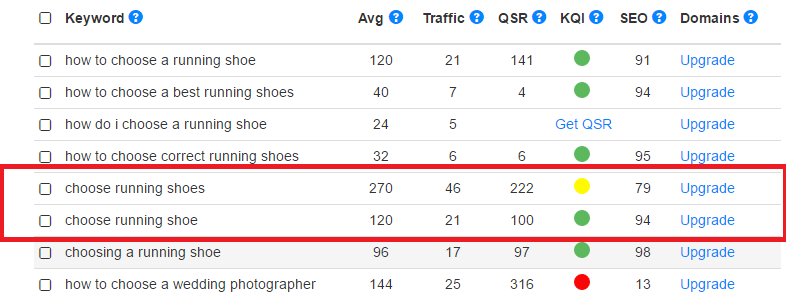
With a list of keywords in place, you can then manually check if you’re targeting non-relevant keywords. This will save minute
9. You don’t track keyword performance.
Your keyword research says you’re going to bring in at least 500 visitors a month for a very targeted keyword. But does it occur to you that you may be getting only a tiny fraction of it while the rest goes to your competitors?
Or worse, your pages barely attract any clicks as they struggle to rank in Google.
If you don’t track how well your keywords are performing, you won’t know what or where to make improvements. The reality is, when you’re hoping to draw visitors to your website, you got to make every single keyword count.
Solution
Check out my post on how to monitor keywords performance and increase search traffic from an awesome trick I learned from Nick Patel.
10. You don’t use sales converting keyword.
It’s true that most blogs don’t make a lot of money in their lifetime. Not because they produce below par contents or having little traffic.
It’s because they don’t sell at all.
They avoided words like “Cheapest”, “Buy”, “Review“, and “Sales” when they crafted their page titles and content.
I know some bloggers avoided selling like a plague, simply because of the common saying of “people love to buy but hate to be sold to“.
You don’t need to have every single page screaming “buy me” at your readers. But you need to have some pages for direct readers who actually trusted you to make a purchase from your site.
Solution
A change of mindset is in order.
Stop hesitating in recommending your trusted readers a product or program that you have used and trusted. You can start learning about how to develop proper sales funnel and strategy for conversion.
There are loads of online resources on this if you are willing to search around.
11. You only use FREE tools like Google Keyword Planner.
Are we looking at 100K or 1 million monthly searches? What about the actual Click Through Rate (CTR) for a particular keyword?
How many competitors you’ll face for a particular keyword. Try as you may but relying on FREE tools like Google Keyword Planner and the search engine itself has its own limitation.
For one, it is time-consuming just to get the parameters right for a single keyword.
If you’re serious about producing a quality website that ranks, you’re going to spend more time on planning, developing content, and more marketing and less time tinkering with multiple free keyword research tools.
Solution
There are many paid keyword research tools out there that promise a handful of features. But there are only 3 important parameters that I used in getting my pages to rank high on Google. They are monthly searches, projected traffics and competitors. I’ll recommend you to try Jaaxy for FREE to actually experience how much time you’ll save compared to using FREE tools.
You can start searching your next profitable keyword here.
Over To You
Did I miss out any keyword mistakes that I should have included? Are you making any of these on your blog? Do you have a better solution? Share your thoughts in the comment below.
If you find this post helpful, share it on Facebook, tweet it, +1 or pin it on your Pinterest board.
Hey, it’s Kenny here. I’m a single dad, freelance writer, an affiliate marketer. I have been making a living online since 2016, after quitting a 10-years engineering profession. When I’m not on the laptop, I’ll be in the kitchen experimenting with new cuisines.



Great article! I’ve definitely found myself making a few of these mistakes in the beginning – so I can relate. I especially like the piece of advice you get about using keywords that are later in a consumer’s buying lifecycle – I think those are very effective. I’m going to read your other post about tracking keyword performance, because that’s something I’m currently not doing and I think a lot of folks forget to as well.
Hi Helder,
Thanks. I’m glad that you like my post.
Cheers,
Kenny
Hi, I really liked your post. It is really informative and I learned a few things as I read it.
I’m going to keep this great information in mind. I am making some of these mistakes but thanks to your post, I now know what not to do.
Thanks so much!
Hi Chris,
Thanks for checking my post and sharing your thought.
Cheers,
Kenny
Thanks for this! I’m still trying to get my blog to really take off, and my posts just aren’t climbing the ranks and getting me traffic, even with using a tool similar to Jaaxy for my keyword research (Wealthy Affiliate tool). I read your post very carefully and I think I have some ideas as to what sorts of keywords to aim for now.
(If you’re interested, I’m thinking that using exact product names in my long tailed keywords isn’t so smart. Higher ranked domains like Amazon and others will always be “more relevant” in the results even though my kw has a very low QSR. I think I need to find more “generic” long tailed keywords that also have low QSRs, and see what happens.)
I appreciate the great read! I clicked through and read a few other posts – you’ve got a great, helpful site here!
Hi Marlaine,
Thanks for reading and also your tips on not using exact product names. It make sense somehow that higher authority site will be at the top of the search result for that.
Cheers,
Kenny
Great content I have to say. It’s so helpful that I’m truly gonna bookmark your page and whenever I write posts or pages I’m gonna come back to it.
Never knew the difference between searching a group of keywords and searching a group of quoted keywords.
Thank you for your article!
Hi Andrei,
Thanks for checking out my post. Yes, many are unaware of broad match and phrase match.
Cheers,
Kenny
Hi,
Awesome information, I am trying to read a keyword blog/article everyday. I am doing this for 8 days right now but this one is a clear/good one. I actually make 4 of the 11 mistakes and I am going to fix them from right now.
Another question, which social media plugin do you use? And which one for the Free E-Book layer that is coming up?
Kind regards,
Levi
Hi Levi,
I’m glad my post helps you. I’m using SumoMe for social share and pop-ups. YOu can try their FREE version.
Cheers,
Kenny
Thank you so much for this thorough article. Keyword research is very new and scary to me. I really want to be successful online but getting the money to pay for a program like Jaaxy is very hard for me right now. I have been using the keyword research tool on Wealthy Affiliate. I hope that I am understanding the tool correctly. Unfortunately, unlike Jaaxy it doesn’t really tell me if it is a great keyword. I tend to try to evaluate the competition piece.
Do you have any suggestions for people who are just getting started and don’t have the start up money for Jaaxy? I would appreciate it.
Hi,
If you’re with Wealthy Affiliate, the keyword research tool is sufficient to get your page to rank. You just need to pay attention to the search, traffic and competition score in selecting your keyword. I used that to rank my other blog in Google.
Cheers,
Kenny
Hi
Great Blog with some very useful information and I have it bookmarked for future use.
There are some tips in here which I was not aware of, and I look forward to implementing some of this advice.
Getting pages ranked by google is essential to succeeding online, and it seems that sometimes even the smallest of mistakes can effect rankings.
I look forward to some of your future posts.
Cheers
Hi Chris,
Thanks for loving my post. Organic traffic is still the best for me as they are people who are actually looking for information.
Cheers,
Kenny
Hey Kenny,
Really good guide, I never thought about the trends research part though. Usually I only do research on keywords, write them and rank.
But for some of my articles, they don’t get traffic much after few months even though they are on the first page and now I know why – Its the trend! Found my mistake, thanks for sharing this man!
Hi Riaz,
It happens when we are targeting products that are getting obsolete on the market. It’s prudent to do a quick check on Google Trend.
Cheers,
Kenny
Hi there Kenny,
Bravo! Outstanding article, thanks for creating and sharing it with is. It is really appreciated.
I have seen myself making some of those errors – and in particular the “s” thing.
You did n’t mention it, but one error is going for longtail keywords that dont form a proper sentence in English is one mistake and of course chasing after keywords that are not relevant to the site you are creating! relevance is key!
Hi Derek,
Yes. Sometimes making careless grammar mistake could be costly too. I’ll include that in my next update.
Thanks.
Cheers,
Kenny
Awesome article on keywords. I can’t emphasize enough how important they are to getting visitors to your site. I am still learning. Thanks for this. You can work really hard and no one will visit your store. Not good.
Keywords are key!
Hi Peter,
Thanks for reading and sharing your thoughts.
Cheers,
Kenny
Hey Kenny really interesting article , as i’m just starting with my blog it’s still really hard for me to use the right keywords.
Sometimes i come up with an idea and try to get good keywords but then some of them take me to another idea and i end up in total confusion….also i never know where to put them i try to do it always in the title or just around my post basically.
If you have any suggestion and a kind of path to follow for me i’ll really appreciate it!
thanks.
Hi Luca,
Thanks for checking out my post. I’ll be writing a new post on keyword placement for your blog post. I’ll let you know when it’s published.
Cheers,
Kenny
Hello and thanks for sharing, this is a awesome post on key word research mistakes, I did not know about all that has to to with keywords. You post have broken this all down and gone in depth. Keywords are so in important because this is how you get a rank in google and then that will all convert. Thanks again for sharing, I believe that we all that are in this business need this kind of information that you are offering.
Great tips on keyword research Kenny. I am definitely weak in this area and I struggle all the time. I may have to invest in Jaaxy when I get some money.
Hi Peter,
Thanks for reading.
Cheers,
Kenny
Thank you for the great advice.
I just wanted to share about your tip using the long tail keywords. I had my site going for 12 months and thought I had researched good keywords… but they just weren’t ranking anywhere near the top of Google.
It turns out I’m in a very competitive niche, so I went back through my posts and made my target keywords longer int he title, meta title and description and within the content itself and the result was a more specific, less competitive keyword that I could rank for.
It;s a great idea to spruce up those old posts you worked hard on but they never saw the light of day.
You’re clearly a pro at what you do, thanks for sharing your expertice and advice.
Hi Simon,
Thanks for your compliment, and I’m glad my article reflects your experience.
Cheers,
Kenny
Hello Kenny,
your article has been so helpful, I never knew there so many mistakes I do which i need to avoid. Sometimes you write an article and will be expecting that I should easily get ranked with this article. But then you realize that you will wait for month and not good result.
I know know the trick of using this long tail keywords.So that at least I can beat some of my competitors whose website are far in of my own.
I have seen Jaaxy as you recommended, it looks so good with all the data it displays, I think I’m beginning to like it.
I will surely give it a try and see how it helps me improve my site ranking
Hi Stephen,
Thanks for checking out my article. hope it helps with your ranking.
Cheers,
Kenny